Editor’s Note: Today’s guest feature is our contributor Greg Moats.
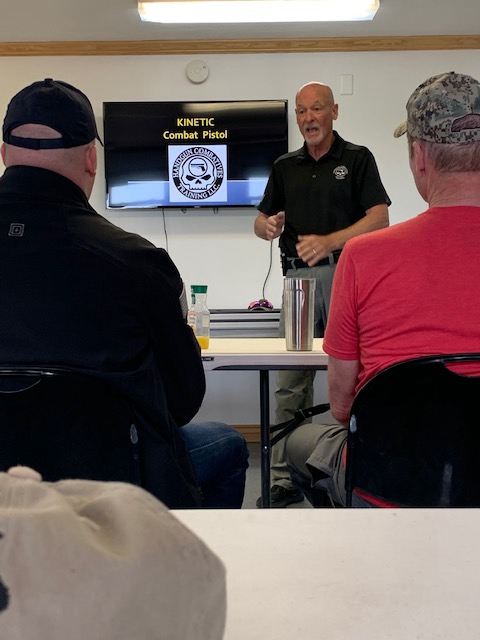
I once boxed a guy that boxed a guy that boxed Sugar Ray Leonard. In actuality I was taking boxing lessons and got beat up by a guy that was the sparring partner and whipping boy of a guy that got knocked out in the first round by Sugar Ray Leonard. (For self esteem purposes I generally only reference the first sentence). At the time I was playing college football and thought of myself as a Dick Butkus in the making. When I regained consciousness and was helped up off of the mat, my illusions of “toughness” evaporated pretty quickly. With a body built for comfort, not speed, I realized that I sure as heck wouldn’t be able to outrun trouble. I decided that I better learn to shoot a gun because neither boxing nor running seemed compatible with my natural aptitude.
Therefore I got involved with IPSC competition on its ground floor in the mid-70’s and was committed and dedicated to the sport until the mid-80’s when it deviated from its original purpose. In 1987 I quit shooting and walked away. Between 1987 and 2006 I shot a total of less than 200 pistol cartridges; when I say “I quit” handgunning, I’m not exaggerating! In 2006, I was re-bit by the pistol bug when I entered a local IDPA match with the sole intent of commemorating the passing of Jeff Cooper. I saw old friends, heard old stories and resurrected old memories…good ones. Within a few months, I was shooting again on a regular basis.
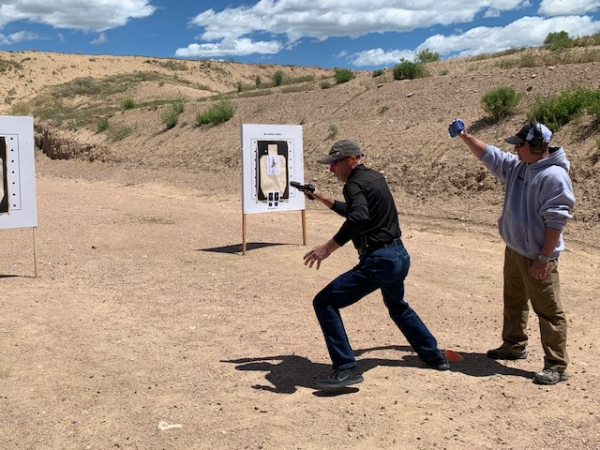
We all know that shooting competence, especially handgun shooting, is a diminishing skill. Your abilities decline at a more rapid rate than they ascend. The 19 year shooting sabbatical that I took was not conducive to good performance. I needed training, badly. I gravitated to the individual that I knew and admired most from the early days for his no-nonsense, logical approach to “practicality,” Ken Hackathorn. I signed my son and myself up for a 2 day class that Ken was conducting, and caught the “training bug.” As Ken was gearing down his training schedule, I learned that his most successful and talented protégé was a guy named Dave Spaulding.
It took a few years, but I finally was able to attend one of Dave’s classes. His “Mindset” presentation blew my mind. He had the no-BS, practical approach that I admired in Hackathorn, and I became a disciple. I attended his 3-day “Combative Pistol” class, hosted his 2-day version of the same program and with some trepidation recently attended his “Kinetic Combat Pistol” course. An abbreviated version of Dave’s web site description of this class says: “It will focus on ‘movement with purpose.’…it is moving explosively and dynamically…..strong emphasis will also be placed on being able to stop quickly, shoot accurately and instantly move again. This is a physical course of instruction….” I’m in the back half of my 7th decade and haven’t moved “explosively and dynamically” since the Reagan administration. My trepidation didn’t center on a fear of being embarrassed, that ship sailed long ago I’m afraid; I wasn’t sure that I was capable of physically performing the drills!
When we gathered on day one, I was pleased to see that I wasn’t the only potential AARP member in the class. Out of 16 students, one was 59, three of us were in our 60’s and one was 71, (although of this geriatric squad I was the only one that appeared to have physically exceeded his “use by” date, the rest looked to be in pretty good shape). Still, at some age your “explosive movement” becomes a “waddle.” This may be because of age, arthritis, gravity enhancement (getting fat), previous injuries, sedentary life-style or, as in my case, a combination of all of the above. The notion of “waddling” while everyone else is moving like a Bruce Lee movie set on “fast forward,” is tough on the ego. Perhaps one of the best pieces of advice for gaining skill at defensive hand gunning was given by an unlikely source, Dale Carnegie, when he said, “the fear of embarrassment is the curse of the human mind.” To my relief, it turned out that I wasn’t the only “waddler” in the class and whether out of mirth or pity, the rest of the class provided encouragement.
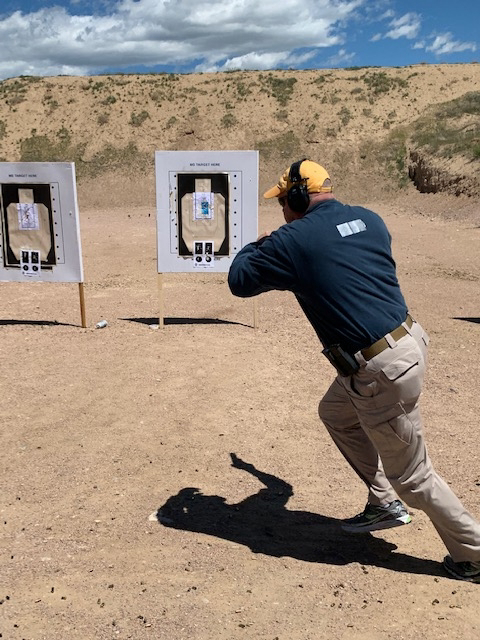
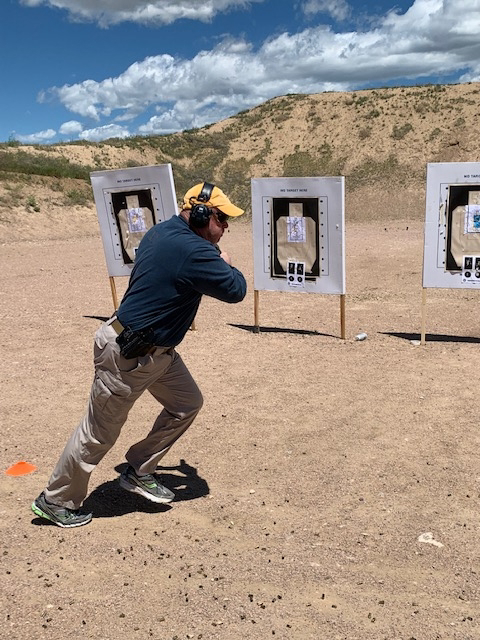
As a former college track star who aspired to be a coach, Spaulding has a talent for explaining his maneuvers and methods of movement in terms of physiological efficiency. This occasionally results in him being at odds with popular doctrine; his “inboard manipulation” of the slide is a prime example. For a man in his early 60’s, Dave is in disgustingly good shape and he physically demonstrates every maneuver and movement on which he drills the class. He’s not of the “if it ain’t broke, don’t fix it” school of thinking. However, if you want to do things your way, that’s ok with Spaulding, he simply explains the reason for his method, demonstrates it and suggests that you give it a try.
I found Dave’s theme, “movement WITH PURPOSE” to be a key ingredient that had been missing in past training that I had received from other trainers. One class that I took required that we keep constantly moving from side to side while reloading. The resultant stutter-step gyrations mimicked a man that had drank too much coffee waiting in line to use the men’s room. When I questioned the previous trainer on the purpose for the stutter-steps I was told that it was insuring that I “got off the X” and it interrupted my adversary’s OODA loop. Really! Moving from “X” half way to “Y” and then back half way to “W” wouldn’t disorient a drunk with vertigo. When Spaulding has you “move off the X,” he has you stop somewhere on the opposite side of the alphabet. Pushing off with the foot opposite to the direction you’re moving without telegraphing your intentions by leaning is not intuitive. Hence it is practiced, then practiced while drawing the handgun, then practiced while drawing and stopping to shoot (without skidding or tipping over).
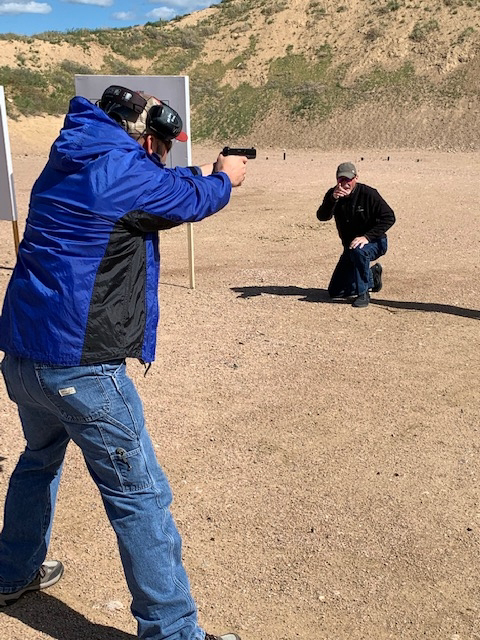
We did side-steps, lateral runs, pivots, sprints (both up and down range) and drills that combined all of the above. The longest distance that we sprinted was only about 10 yards, but we did it a lot, not so much for speed but to imprint how to safely start, stop, pivot and shoot under control. At the end of the class, my thighs and calves felt the burn and the physicality of the exercises had forced an enhanced focus on my shooting. Therein lies one of the key benefits of the class. Unless you’re a competitive 3-gun participant, my guess is that your typical “practice session” at the range rarely incorporates any “explosive movement.” You learn a lot about the degradation of your shooting skills when you’re exhausted and in a little pain.
Dave Spaulding would be the first to tell you that he has as much on his plate as he cares to say Grace over. His classes fill up quickly and he’s actively gearing down the number and frequency of his programs. He doesn’t need me to promote him or his classes. My purpose is to challenge those of you that may be little long-in-the-tooth to step outside of your comfort zone, run the risk of embarrassment, exhaustion and a little pain and take a class that pushes you physically. Dave’s Kinetic Combat Pistol class is a great one and pardon the cliché, but if I can do it, so can you. Father Time is an adversary against which there is little defense other than to avoid stagnation.
- Greg Moats
Greg Moats was one of the original IPSC Section Coordinators appointed by Jeff Cooper shortly after its inception at the Columbia Conference. In the early 1980’s, he worked briefly for Bianchi Gunleather and wrote for American Handgunner and Guns. He served as a reserve police officer in a firearms training role and was a Marine Corps Infantry Officer in the mid-1970’s. He claims neither snake-eater nor Serpico status but is a self-proclaimed “training junkie.”